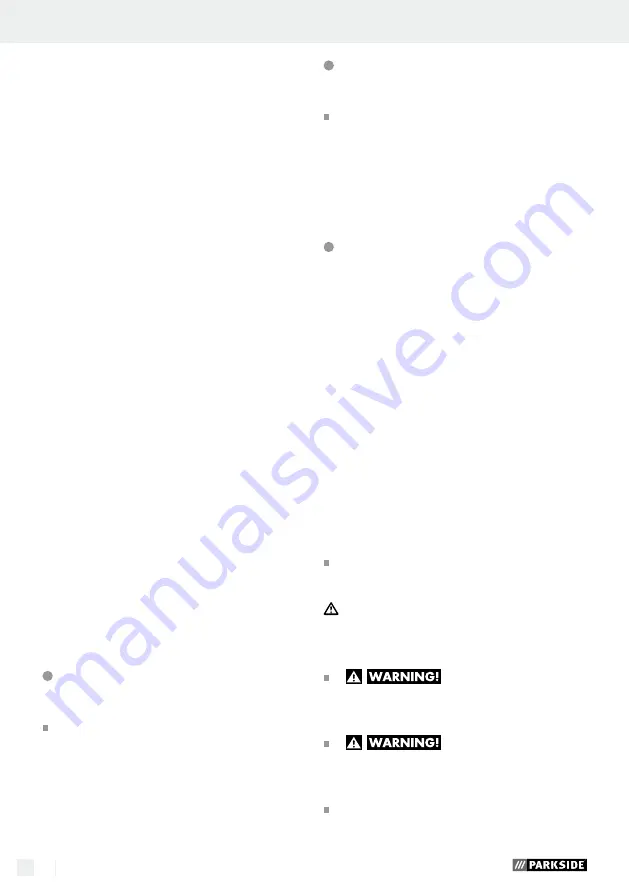
54 GB/MT
General safety advice for electrical power tools / Operation
General safety advice for electrical power tools
creases the load and the tendency of the disc
to twist or snag in the cut, making kickback or
disc breakage more likely.
b)
Avoid the area in front of or behind
the rotating cutting disc.
If the cutting disc
is moving away from you at the point of con-
straint in the workpiece, then, in the event of
a kickback, the electrical power tool and the
rotating disc may be thrown towards you.
c)
If the cutting disc jams or you stop
work for a while, switch the device
off and hold it until the disc comes to
a complete stop. Never attempt to
pull the still rotating cutting disc out of
the cut as this could cause kickback.
Determine and rectify the reason for the jamming.
d)
Do not switch on the device if the cut-
ting disc is in the workpiece. Allow the
cutting disc to reach full speed before
carefully continuing with the cut.
Oth-
erwise the disc could snag, jump out of the
workpiece or cause a kickback.
e)
Support boards or workpieces whilst
cutting to reduce the risk of kickback
caused by a jammed cutting disc.
Large
workpieces may bend under their own weight.
The workpiece must be supported to both sides
of the cutting disc and particularly near the
cutting disc and at the workpiece edge.
f)
Be particularly careful when pocket
cutting in existing walls or other areas
where you cannot see what you are cut-
ting into.
The cutting disc plunged into the surface
could cut through gas or water pipes, electricity
cables or other objects and cause kickback.
Special safety advice for
abrading using sandpaper
Do not use over-sized sanding sheets.
Follow the manufacturer’s recommen-
dations for sanding sheet size.
Sanding
sheets that project beyond the backing pad
could cause injury in addition to jamming,
tearing of the sheet or kickback.
Special safety
advice for polishing
Do not use the polishing bonnet if it
has any loose parts, in particular the
fastening cords.
Tuck the fastening cords
away or trim them. Loose fastening cords rotat-
ing with the attachment could catch your fingers
or become trapped in the workpiece.
Special safety advice for
working with wire brushes
a)
Bear in mind that wire brushes lose
pieces of wire during normal use. Do
not overload the wires by applying too
much pressure.
Flying pieces of wire can very
easily penetrate thin clothing and / or skin.
b)
Use a guard, if recommended, but
make sure that the wire brush does
not come into contact with the guard.
The diameters of disc brushes and cup brushes
can increase due to contact pressure and cen-
tripetal forces.
Q
Safety advice applicable specif-
ically to cordless multigrinders
When you use the drill / grinder wear the fol-
lowing protective equipment: safety glasses
and protective gloves.
CAUTION! RISK OF INJURY!
The tool
continues to rotate after it has been switched
off! Avoid contact with rapidly rotating drill /
grinder components.
Securely support the work-
piece. Use clamps or a vice to grip the workpiece
firmly. This is much safer than holding it in your
hand.
RISK OF INJURY!
Never
support yourself by placing your hands near or
in front of the device or the workpiece surface.
A slip can result in injury.
DANGER OF FIRE FROM FLYING SPARKS!
Abrading metal creates flying sparks. For this
reason, always make sure that nobody is placed
Summary of Contents for PFBS 9.6 A1
Page 3: ...6 4 8 3 7 D E F G H 18 4a 3a 1 2 5 A 11 9 10 C B 16 14 15 19 22 20 21 12 23 13 18 17...
Page 4: ......
Page 18: ...18...
Page 60: ...60...
















































